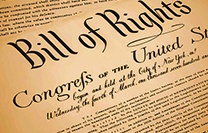SECTION III: Creating the Bill of Rights
 To gain ratification of the Constitution, there emerged a gentlemen's agreement among state
delegations that one of the first orders of business of the 1st Congress of the United States would
be to address what many believed to be the lack of specific protections against a too-powerful
federal government. From that agreement came ten amendments to the Constitution, which we now call
the Bill of Rights.V
To gain ratification of the Constitution, there emerged a gentlemen's agreement among state
delegations that one of the first orders of business of the 1st Congress of the United States would
be to address what many believed to be the lack of specific protections against a too-powerful
federal government. From that agreement came ten amendments to the Constitution, which we now call
the Bill of Rights.V
Other sections of KTBB Constitution Minute:
Prologue: Articles of Confederation || Section 1:
Constitutional Covention ||
Section 2: Ratification || Section 3: Creating the Bill of Rights || Section 4:
The Ammendments || Section 5: The Courts and the Landmark Decisions ||
Section 6: The Present Day || Section 7: The Founding
Fathers
 Episode 47: Patrick Henry's Opposition
Episode 47: Patrick Henry's Opposition
With the new Constitution ratified by all but two states, it looked as if anti-federalist opponents of the Constitution, such as Patrick Henry, had conceded defeat. Such was not the case at all. Listen to Episode 47
 Episode 48: Henry vs. Madison
Episode 48: Henry vs. Madison
Virginia, at the time the most populous state, was home to both the Constitution’s principal architect, James Madison, and its principal opponent, Patrick Henry. The two were about to square off on one another. Listen to Episode 48
 Episode 49: Warming to Amendment
Episode 49: Warming to Amendment
Between June 1788, when the Constitution was ratified, and March 1789, when the government was set to begin operating under its provisions, opinion ran high on both sides of the argument that it was in need of amendment so that individual and state rights would be better protected. Listen to Episode 49
 Episode 50: Help From the Baptists
Episode 50: Help From the Baptists
So that he might better protect his hard work at the Constitutional Convention from those who would undo it, James Madison ran against long odds in an attempt to win a seat in the House of Representatives from his home state of Virginia. He had help in that effort from an unlikely source. Listen to Episode 50
 Episode 51: Madison Evolves
Episode 51: Madison Evolves
When the Constitution was ratified, its principal author James Madison strongly believed that it was sufficient as written. But as fear grew that the new document left too many doors open to a too-powerful federal government, Madison began to come around. Listen to Episode 51
 Episode 52: Madison Wins Election to the House
Episode 52: Madison Wins Election to the House
As elections were being held to send members to the First Congress, Madison believed that in his absence from that body, those who still disapproved of the new Constitution might force a new convention that would undo it. That fear made Madison’s campaign for Congress all the more urgent. Listen to Episode 52
 Episode 53: The First Congress
Episode 53: The First Congress
James Madison won election to the House of Representatives and the First Congress met in New York in the early spring of 1789. Listen to Episode 53
 Episode 54: Madison Introduces Amendments
Episode 54: Madison Introduces Amendments
By the opening of the First Congress, James Madison had completed an about face regarding the need for immediate amendment of the new Constitution. Listen to Episode 54
 Episode 55: June 8, 1789
Episode 55: June 8, 1789
On June 8, 1789 James Madison rose on the floor of the House of Representatives and gave what was perhaps the most important speech of his spectacular political career. Listen to Episode 55
 Episode 56: Protection of Liberty
Episode 56: Protection of Liberty
Just as James Madison had met stern resistance to ratification of the Constitution in the Fall of 1788, by the summer of 1789 he was meeting stern resistance to the idea that it was in need of immediate amendment. Listen to Episode 56
 Episode 57: Vice and Errors
Episode 57: Vice and Errors
Elbridge Gerry of Massachusetts, who at the Constitutional Convention refused to sign the document, defended it in the First Congress by acknowledging both its virtues and its vices and errors. Listen to Episode 57
 Episode 58: The House Takes Up Debate
Episode 58: The House Takes Up Debate
Six intense weeks followed James Madison’s proposal to immediately amend the Constitution and the Congress’s agreement to take up the proposal. Listen to Episode 58
 Episode 59: The House Votes
Episode 59: The House Votes
James Madison originally proposed nine amendments to the Constitution. That list expanded to 20 before being whittled down to 17. On August 24, 1789, after 11 days of debate, the House of Representatives voted to approve the amendments and send them to the Senate. Listen to Episode 59
 Episode 60: Cool Reception in the Senate
Episode 60: Cool Reception in the Senate
Having received them from the House of Representatives on August 25, 1789, the 17 proposed amendments to the Constitution were read aloud in the Senate. The reading was not warmly received. Listen to Episode 60
 Episode
61: The Senate Approves
Episode
61: The Senate Approves
After vigorous debate in the Senate, the list of 17 proposed amendments to the Constitution that the Senate had received from the House was consolidated and whittled down to 12. On September 14, 1789, those 12 proposed amendments were approved. Listen to Episode 61
 Episode 62: The Bill of Rights Approved by Congress
Episode 62: The Bill of Rights Approved by Congress
After debate in a conference committee between the House of Representatives and the Senate, 12 proposed amendments to the Constitution were approved by both chambers and sent to the states. Ten of those amendments are together known today as, The Bill of Rights. Listen to Episode 62


